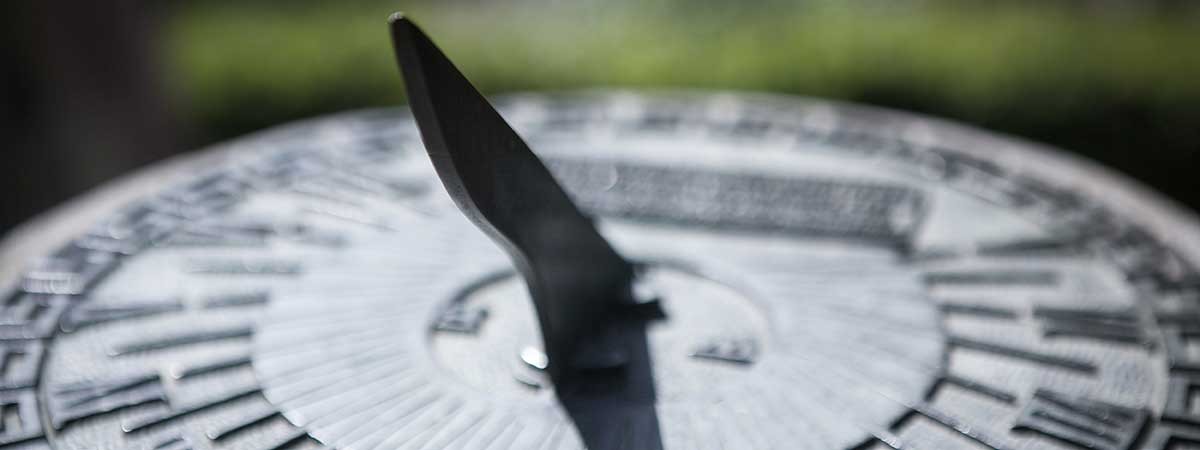Vacuum chambers containing free-floating atoms are at the heart of today's most precise instruments for measuring time. Laser pulses function as a timing generator for the newest generation of atomic clocks. They are incredibly precise.
What is time? Neither physicists nor philosophers can answer this question. But this does not stop people from dividing it into intervals and measuring it as precisely as possible. Timekeepers like the sun dials of antiquity or the mechanical tower clocks of the middle ages were important stages of development for the way we measure time. One key technical advancement was achieved by the mathematician and physicist Christian Huygens in the 17th century. His pendulum clock precisely divided time into hours, minutes and seconds for the very first time. Since then, increasingly precise measurement tools have been developed. Today, caesium atomic clocks are the basis for official standardized universal time and lose only one second every 30 million years.
Caesium atomic clocks keep the world's time
These modern timekeepers do not have pendulums or hands. Instead, atoms of caesium "tick" the time away. They are heated until they boil off and are then passed into a tube with a high vacuum. The low pressure ensures that the atoms do not bump into each other and pass through the chamber with high energy. The atoms are then exposed to microwave radiation. The right frequency, referred to by physicists as the resonant frequency, changes the energy state of some of the atoms. They are "excited" and counted by a detector.
Now the microwave frequencies are adjusted until the energy state of the largest possible number of caesium atoms changes. This happens reliably at 9,192,631,770 Hertz ֠so over nine billion oscillations per second. Inversely, one second passes when this number is reached. Thus is this the basis for defining the length of a second in the SI International System of Units.
Even more precision with lasers
In addition to caesium radiation clocks, caesium fountain clocks are also used as reference clocks for universal time today. In these clocks, caesium atoms are introduced into the vacuum chamber ֠in a way that resembles a fountain ֠before they are radiated with microwaves. Because the resonant frequency of the atoms can be even more precisely determined using this trick, fountain clocks will, at most, only lose one second in 40 million years.
Optical atomic clocks using strontium or ytterbium atoms, for example, are even more precise. Instead of using microwaves, the atoms are excited with lasers, also in an ultra high vacuum. The light frequency that results when one atom changes its energy state serves as the reference for the length of a second. The frequency is higher and the electron transition frequency is faster, such that time can be divided into even smaller intervals. The optical clocks "tick" much faster and at more exact intervals than caesium clocks. They may become the new timekeepers for universal time, making it necessary to redefine the unit of time we know as a second. Regardless of the process, all types of atomic clocks require a vacuum chamber for their reference atoms.

The future of time measurement
Vacuum technology is essential for optical atomic clocks
Why do we need extremely precisely measured time?
Hardly anyone is aware of the fact that atomic clocks have long set the rhythm of our everyday lives, for example by setting the time for radio-controlled clocks and clocks in train stations. GPS systems would not be able to ensure reliable navigation without the atomic timekeepers: GPS receivers, such as the navigation systems in our cars, constantly register information from GPS satellites that transmit their respective positions and time. The receiver uses data from three satellites to find the exact position by calculating the difference between transmission and reception of the signals. A deviation of only a millionth of a second would offset the reading by 300 metres.
Atomic clocks are also necessary for synchronizing high-speed data networks. Long optical glass fibre transmission lines have to very precisely coordinate sending and receiving in order to prevent data chaos.
Hyper-exact measurement of time is also needed for geodetic applications and basic research. The newest generation of atomic clocks helps measure Einstein's postulation about how time is stretched by Earth's gravity, or it may help us locate dark matter.
Hardly anyone is aware of the fact that atomic clocks have long set the rhythm of our everyday lives, for example by setting the time for radio-controlled clocks and clocks in train stations. GPS systems would not be able to ensure reliable navigation without the atomic timekeepers: GPS receivers, such as the navigation systems in our cars, constantly register information from GPS satellites that transmit their respective positions and time. The receiver uses data from three satellites to find the exact position by calculating the difference between transmission and reception of the signals. A deviation of only a millionth of a second would offset the reading by 300 metres.
Atomic clocks are also necessary for synchronizing high-speed data networks. Long optical glass fibre transmission lines have to very precisely coordinate sending and receiving in order to prevent data chaos.
Hyper-exact measurement of time is also needed for geodetic applications and basic research. The newest generation of atomic clocks helps measure Einstein's postulation about how time is stretched by Earth's gravity, or it may help us locate dark matter.